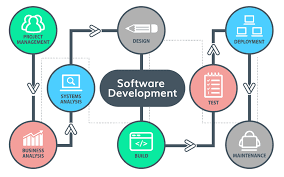Mastering Java Software Development: Building Robust Applications with Java
The Power of Java Software Development
Java is a versatile and powerful programming language that has been a cornerstone in software development for decades. Known for its portability, reliability, and scalability, Java is widely used in a variety of applications, from enterprise systems to mobile apps.
One of the key strengths of Java is its platform independence. Developers can write code once and run it on any platform that supports Java without the need for recompilation. This “write once, run anywhere” capability has made Java a popular choice for building cross-platform applications.
Java’s robust standard library provides developers with a wide range of tools and functionalities to streamline development processes. From data structures to networking capabilities, Java offers built-in support for many common tasks, reducing the need for developers to reinvent the wheel.
Furthermore, Java’s strong emphasis on object-oriented programming principles promotes code reusability and maintainability. By organizing code into classes and objects, developers can create modular and scalable applications that are easier to manage and extend over time.
In addition to its core features, Java has a vibrant ecosystem of frameworks and libraries that further enhance its capabilities. Frameworks like Spring and Hibernate provide developers with powerful tools for building web applications and interacting with databases efficiently.
With its wide adoption in both enterprise and open-source projects, Java continues to be a top choice for software development across various industries. Whether you’re building an enterprise application or a mobile game, Java’s versatility and reliability make it an excellent choice for bringing your ideas to life.
Top 6 Frequently Asked Questions About Java Software Development
- What is Java and why is it used in software development?
- What are the key features of Java that make it popular for software development?
- How does Java support platform independence in software development?
- What are some common tools and libraries used in Java software development?
- Can you explain the concept of object-oriented programming in relation to Java?
- Which industries or applications commonly use Java for software development?
What is Java and why is it used in software development?
Java is a popular programming language renowned for its versatility and robustness in software development. It is widely used due to its platform independence, allowing developers to write code once and run it on any platform that supports Java without the need for recompilation. Java’s rich standard library provides developers with a plethora of tools and functionalities, simplifying the development process. Its strong emphasis on object-oriented programming promotes code reusability and maintainability, making it easier to create scalable applications. With a vibrant ecosystem of frameworks and libraries, Java empowers developers to build a wide range of applications efficiently, from enterprise systems to mobile apps.
What are the key features of Java that make it popular for software development?
Java is a popular choice for software development due to its key features that set it apart from other programming languages. One of the main reasons for Java’s popularity is its platform independence, allowing developers to write code once and run it on any platform without recompilation. Additionally, Java’s robust standard library provides a wide range of tools and functionalities that streamline development processes. The language’s emphasis on object-oriented programming principles promotes code reusability and maintainability, making it easier for developers to create modular and scalable applications. Furthermore, Java’s vibrant ecosystem of frameworks and libraries enhances its capabilities, making it a versatile and reliable option for building a wide range of applications.
How does Java support platform independence in software development?
Java achieves platform independence in software development through its unique approach to compilation and execution. When a Java program is compiled, it is converted into an intermediate bytecode format instead of machine code specific to a particular platform. This bytecode can then be executed on any system with a Java Virtual Machine (JVM), which acts as a platform-specific interpreter for the bytecode. By decoupling the compiled code from the underlying hardware and operating system, Java allows developers to write code once and run it on any platform that supports the JVM, making it truly platform-independent and enabling the famous “write once, run anywhere” capability that simplifies cross-platform development in software projects.
What are some common tools and libraries used in Java software development?
In Java software development, developers often rely on a variety of tools and libraries to streamline their workflow and enhance the functionality of their applications. Some common tools include Integrated Development Environments (IDEs) such as Eclipse, IntelliJ IDEA, and NetBeans, which provide powerful features like code editing, debugging, and project management. Additionally, build automation tools like Apache Maven and Gradle help automate the build process and manage dependencies efficiently. When it comes to libraries, popular choices include Apache Commons for reusable Java components, Guava for utility classes and collections enhancements, and Log4j for logging capabilities. These tools and libraries play a crucial role in Java development by simplifying complex tasks and accelerating the development process.
Can you explain the concept of object-oriented programming in relation to Java?
In Java software development, understanding the concept of object-oriented programming is crucial. Object-oriented programming (OOP) is a programming paradigm that revolves around the concept of objects, which are instances of classes. In Java, everything is treated as an object, and OOP principles like encapsulation, inheritance, and polymorphism play a vital role in designing and structuring code. Encapsulation allows data hiding and protects the internal state of objects, ensuring data integrity. Inheritance enables the creation of new classes based on existing ones, promoting code reuse and hierarchy. Polymorphism allows objects to take on different forms or behaviors based on their context, enhancing flexibility and extensibility in Java applications. By embracing OOP concepts in Java development, programmers can create modular, maintainable, and scalable software solutions efficiently.
Which industries or applications commonly use Java for software development?
In the realm of software development, Java finds widespread application across a multitude of industries and sectors. From financial institutions and healthcare providers to e-commerce platforms and telecommunications companies, Java serves as a versatile and reliable tool for building robust and scalable applications. Its platform independence and extensive library support make it a popular choice for developing enterprise systems, web applications, mobile apps, and more. Java’s flexibility and performance have made it a go-to language for industries that prioritize stability, security, and cross-platform compatibility in their software solutions.












